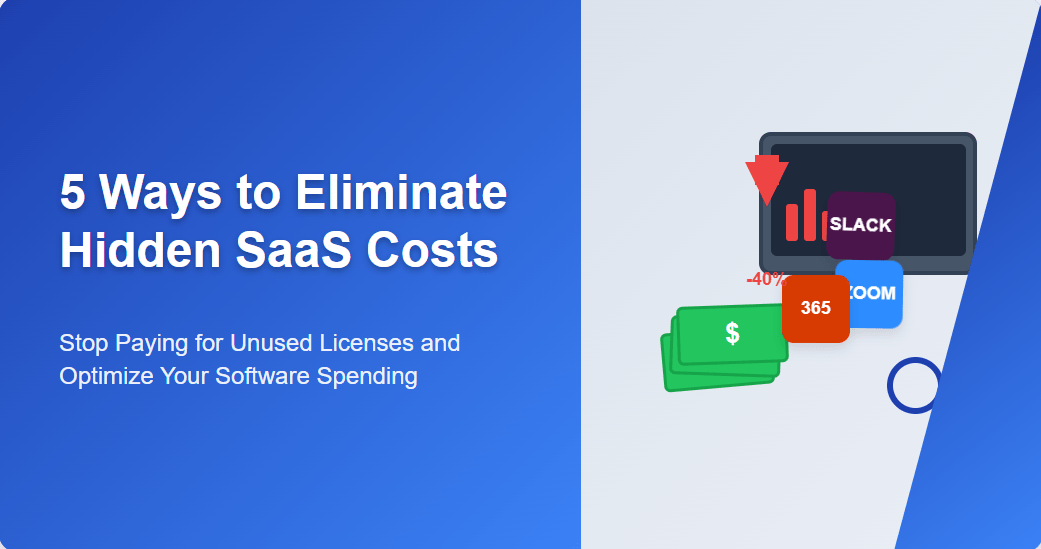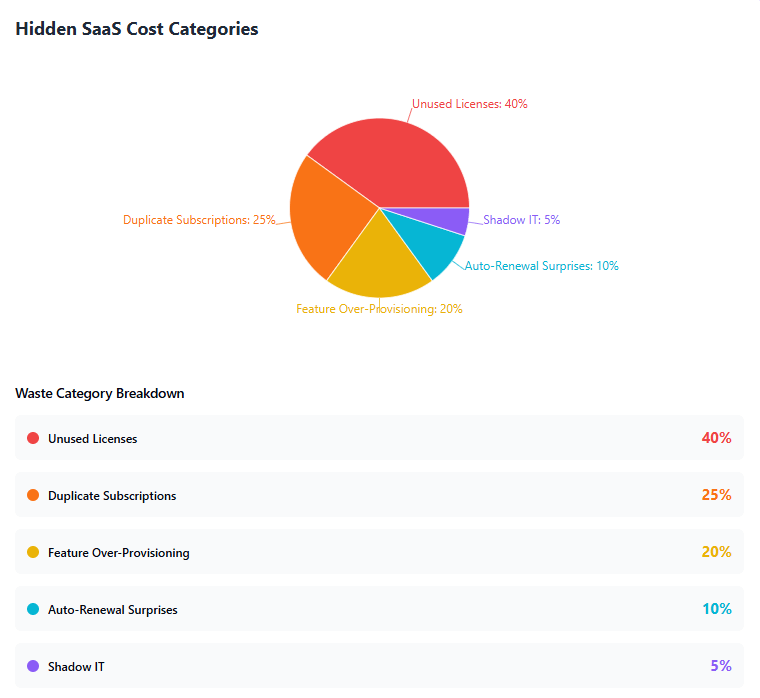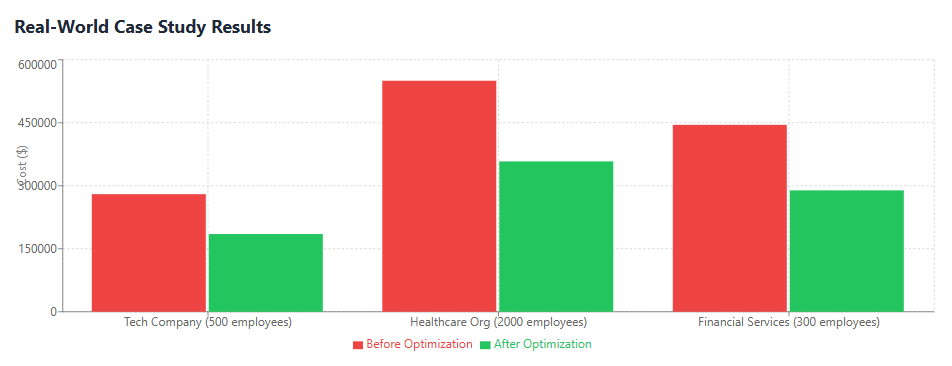
The modern enterprise manages an average of 80+ SaaS subscriptions, creating unprecedented flexibility but also introducing complex hidden costs that can drain budgets. Research indicates that organizations waste 30-40% of their software spending on unused or underutilized SaaS licenses, representing millions of dollars in recoverable costs for larger enterprises.
Hidden SaaS costs often emerge from unused licenses, redundant subscriptions, automatic renewals, and poor visibility into actual software utilization. This comprehensive guide presents five proven strategies to eliminate these hidden costs and optimize your software spending while maintaining operational efficiency.
Understanding how SaaS software is distributed through subscription models creates unique challenges for cost management, as traditional software budgeting approaches often fail to account for the dynamic nature of SaaS licensing.
What Are Hidden SaaS Costs?
Hidden SaaS costs encompass various forms of unnecessary expenses that accumulate within an organization’s software ecosystem. Unlike obvious budget line items, these costs often remain invisible until a comprehensive audit reveals their true financial impact.
Common Types of Hidden SaaS Costs:
Unused License Costs represent the most common form of waste, occurring when organizations continue paying for software licenses that employees no longer actively use. This includes departing employees whose licenses remain active, seasonal workers whose access extends beyond their tenure, and software that loses relevance as business needs evolve.
Duplicate Subscriptions emerge when different departments independently purchase similar software solutions without central oversight. Multiple teams might subscribe to different project management tools, communication platforms, or analytics software that serve overlapping functions.
Feature Over-Provisioning occurs when organizations pay for premium features or higher subscription tiers that remain largely unused. Many SaaS vendors employ tiered pricing models that encourage upgrades through feature bundling, leading businesses to purchase capabilities they don’t actually need.
Auto-Renewal Surprises create unexpected budget impacts when subscriptions automatically renew without proper review processes. These renewals often include price increases or expanded user counts that weren’t properly evaluated.
Shadow IT Subscriptions occur when employees independently purchase SaaS tools using personal credit cards or departmental budgets, creating subscriptions outside official IT oversight. These unauthorized purchases create hidden costs and potential security risks.

The cumulative impact extends beyond immediate financial implications, affecting budget planning, operational efficiency, and compliance. Effective SaaS spend management requires systematic approaches to identify and eliminate these waste sources.
5 Ways to Eliminate Hidden SaaS Costs
1. Implement Centralized SaaS License Tracking
Centralized license tracking provides the visibility foundation necessary to identify waste and optimize spending. Without comprehensive tracking, organizations operate blind to their actual software inventory and utilization patterns.
Establishing a Complete Software Inventory
Create a centralized repository capturing all SaaS subscriptions from multiple sources across the organization. This inventory should include subscription costs, renewal dates, assigned users, feature utilization, vendor contacts, and integration dependencies. Many organizations discover they have 2-3 times more subscriptions than initially estimated.
Automated Discovery and Monitoring
Modern SaaS optimization platforms automatically discover applications by monitoring network traffic, analyzing email receipts, scanning corporate credit card statements, and integrating with identity management systems. This automated approach ensures comprehensive coverage while reducing manual effort.
Creating Accountability
Each subscription should have a designated owner responsible for evaluating necessity, managing user access, and making renewal decisions. Regular reporting to subscription owners should include utilization metrics, cost trends, and upcoming renewal dates.
Financial System Integration
Connect SaaS tracking systems with financial management platforms for real-time visibility into spending patterns and budget impacts. Automated alerts for unusual spending patterns or approaching renewal dates help prevent surprise expenses.
2. Conduct Regular License Utilization Audits
Regular audits provide the data necessary to make informed decisions about software subscriptions and identify optimization opportunities. These audits should be systematic, comprehensive, and aligned with business objectives.
Establishing Audit Processes
Most organizations benefit from quarterly comprehensive audits supplemented by monthly reviews of high-cost subscriptions. Each audit should evaluate user activity levels, feature utilization, integration usage, and business value contribution.
Defining Utilization Metrics
Establish clear definitions of adequate utilization with thresholds that vary by application type, user role, and business function. Common metrics include login frequency, feature usage depth, data processing volume, and active user percentages.
Identifying Optimization Opportunities
Audit results typically reveal several optimization categories:
- Completely unused licenses for immediate cancellation
- Underutilized subscriptions suitable for tier downgrades
- Duplicate functionality across multiple applications suggesting consolidation
- Seasonal usage patterns enabling flexible licensing approaches
Action Planning and Follow-Through
Each audit should produce clear documentation of findings, recommendations, and planned actions. Action plans should prioritize high-impact opportunities and establish timelines for implementation with regular follow-up to ensure completion.
3. Establish Automated Renewal Management
Automated renewal management prevents surprise expenses and ensures subscription decisions align with current business needs rather than historical purchasing patterns.
Creating Renewal Calendars
Comprehensive renewal calendars should track all subscription renewal dates, costs, and decision deadlines. Automated alerts should trigger at multiple intervals (90-day, 30-day, and 7-day notifications) to allow proper evaluation time.
Implementing Approval Workflows
Automated renewal should never occur without explicit approval based on current utilization data. Approval workflows should route renewal decisions to appropriate stakeholders with utilization data, cost projections, and business justification requirements.
Negotiation Opportunities
Renewal periods present opportunities for contract negotiation and optimization. Organizations with good renewal processes often achieve 10-20% cost reductions through strategic negotiation. Implementing SaaS renewal best practices includes evaluating alternatives, negotiating multi-year discounts, and adjusting subscription tiers.
Contract Management
Understanding contract terms, cancellation requirements, and commitment periods enables better strategic planning. Automatic renewal clauses should be carefully managed to prevent unwanted commitments exceeding specific cost thresholds.
4. Optimize License Types and Subscription Tiers
License optimization involves matching subscription types and service tiers to actual usage patterns and business needs, often revealing significant cost-saving opportunities without impacting operational capabilities.
Understanding Licensing Models
Modern SaaS platforms offer multiple licensing models including per-user pricing, consumption-based billing, and feature-tiered subscriptions. Understanding these models enables selection of the most cost-effective option for specific usage patterns.
Right-Sizing User Counts and Access
Regular review of user assignments reveals opportunities to optimize license counts and access levels. Implement processes for promptly removing access for departing employees, adjusting permissions for role changes, and evaluating whether temporary workers require full licenses.
Feature Utilization Analysis
Many organizations pay for premium features that remain largely unused. Detailed feature analysis can identify opportunities to downgrade subscription tiers while maintaining necessary functionality for business operations.
Volume Discounts and Consolidation
Evaluate whether volume discounts for consolidated purchasing provide better value than distributed subscriptions. Consider total cost of ownership including management overhead and budget allocation preferences.
5. Create a Centralized SaaS Procurement Process
Centralized procurement prevents redundant purchases, ensures consistent evaluation criteria, and enables better vendor management and negotiation outcomes.
Establishing Procurement Governance
Effective governance requires clear policies, defined approval processes, and designated responsibilities for software acquisition decisions. Policies should address spending thresholds, evaluation criteria, security requirements, and integration considerations while balancing control with operational efficiency.
Standardizing Evaluation Criteria
Consistent evaluation criteria ensure software selection considers total cost of ownership, security implications, integration requirements, and strategic alignment. Use standardized templates and checklists for technical assessment, business case development, and vendor evaluation.
Vendor Management
Centralized procurement enables better vendor relationships through consolidated purchasing, improved negotiation leverage, and consistent contract terms. Maintain vendor scorecards considering pricing, support quality, financial stability, and strategic alignment.
Budget Integration
Integrate procurement processes with budget planning and financial management systems to ensure spending alignment with organizational priorities. Department-specific budget allocations can maintain accountability while benefiting from centralized negotiation.
Technical Evaluation
New acquisitions should undergo technical evaluation ensuring compatibility with existing systems, adequate security controls, and acceptable performance. Consider API availability, authentication integration, data export capabilities, and compliance requirements.

Real-World Success Stories
Technology Company Case Study A 500-employee software company discovered through audit that they were spending $280,000 annually on 47 SaaS applications with dramatically varying utilization rates. The audit revealed 12 applications with no active users (saving $45,000), duplicate functionality enabling consolidation, and premium subscriptions where basic tiers sufficed. Total savings: $95,000 annually (34% reduction).
Healthcare Organization Results A 2,000-employee healthcare system uncovered 73 SaaS subscriptions across departments, many acquired independently. Consolidating five patient communication platforms, three scheduling systems, and multiple analytics tools saved $125,000 annually. Automated user provisioning eliminated former employee license waste, saving an additional $67,000.
Financial Services Success A 300-employee financial advisory firm implemented comprehensive cloud cost optimization revealing $156,000 in annual hidden costs. Greatest savings came from optimizing CRM and financial planning subscriptions, with many advisors downgrading from premium to basic licenses while maintaining functionality.

How Binadox Helps Eliminate Hidden SaaS Costs
Binadox provides comprehensive SaaS cost management capabilities designed to address the specific challenges organizations face in identifying and eliminating hidden costs through automated discovery, detailed utilization tracking, and intelligent optimization recommendations.
Comprehensive Application Discovery Binadox automatically discovers SaaS applications through network traffic analysis, email receipt scanning, credit card monitoring, and SSO integration. This multi-source approach ensures comprehensive coverage including shadow IT subscriptions outside official channels.
Real-Time Utilization Monitoring The platform provides real-time monitoring of usage patterns, enabling identification of unused licenses and optimization opportunities. Detailed analytics show user activity levels, feature usage, and trends over time with immediate visibility into application value.
Automated Renewal Management Binadox’s renewal calendar provides comprehensive visibility into upcoming dates and costs with automated alerts ensuring proactive decision-making. Workflows route renewal decisions to appropriate stakeholders with utilization data and optimization recommendations.
Cost Optimization Recommendations The platform provides intelligent recommendations based on usage patterns, industry benchmarks, and best practices. Recommendations include tier downgrades, license rightsizing, consolidation opportunities, and alternative vendor suggestions prioritized by savings impact.
Integration and Reporting Binadox integrates with financial systems, identity management platforms, and major SaaS applications for comprehensive visibility and streamlined management. Customizable reporting provides stakeholder-specific insights from executive dashboards to detailed operational reports.
Conclusion
Hidden SaaS costs represent a significant but addressable challenge for modern organizations. The five strategies outlined provide a comprehensive approach to identifying, eliminating, and preventing unnecessary software expenses while maintaining operational effectiveness.
Organizations typically achieve 25-40% reductions in SaaS spending through systematic optimization initiatives, often totaling hundreds of thousands or millions of dollars annually. These savings can be redirected toward strategic initiatives and growth investments.
Implementing centralized tracking, conducting regular audits, establishing automated renewal management, optimizing license types, and creating centralized procurement processes creates a foundation for sustained cost management. Understanding comprehensive SaaS subscription management extends beyond cost cutting to strategic software portfolio optimization.
Long-term success requires treating SaaS cost management as an ongoing discipline rather than a one-time project. The complexity of modern SaaS environments requires sophisticated management approaches, but the investment in proper processes and tools provides immediate returns through identified savings and ongoing benefits through improved operational efficiency.
By eliminating hidden costs and optimizing software investments, organizations achieve better financial performance while maintaining the operational advantages that make SaaS solutions essential for modern business success.

